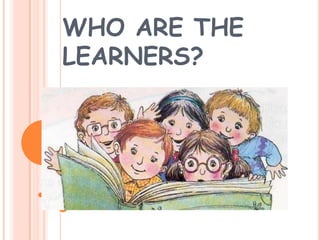
Who are the learners
- 3. Anthony Gregorc (1985) of the University of Connecticut developed a theory of thinking styles based on two variables: our view of the world (wheter we see the world in an abstract or concrete way) ando how we order the world (in a sequencial or random order).
- 4. CONCRETE RANDOMS Characteristics of learners. Have an experimental attitude and behavior; are intuitive; are divergent thinkers; enjoy finding alternate ways of solving problems.
- 5. CONCRETE SEQUENTIAL Implicactions for the classroom. These learners need opportunities to make choices about their learning. They like independent work without teacher intervention.
- 6. Implications for the classsroom. These learners require structure, frameworks, timelines, and organization to their learning. They like lecture and teacher directed activities.
- 7. ABSTRACT SEQUENCIAL. Characteristics of learners. Prefer to decode written, verbal and image symbols; delight in theory and abstract thought; rational and logical.
- 8. Implications for the classroom. These learners prefer presentations and lectures that have substance and are rational and sequential in nature
- 9. ABSTRACT RANDOM. Characteristics of learners. Live in a world of feelings and emotion; associate the medium with the message; evaluate learning experience as a whole.
- 10. Implications for the classroom. These learners prefer to receive information in gropu discussion. Cooperative groups and partners facilitate learning.
- 11. EMOTIONAL INTELLIGENCE Another distinguishing characteristic that makes brains unique is emotional intelligence , or the ability to use one’s emotions intelligently. Emotion intelligence includes five domains. Students differ dramatically with respect to demonstrating competencies in each of these domains.
- 13. THE WORLD OF THE FUTURE It has been said that parents and teachers prepare students for a world they will never know. It is a world unfamiliar. 1. identify, organize, plan, and allocate resources. 2. work with others. 3. acquire and use information. 4. understand complex interrelationships. 5. work with a variety of technologies
